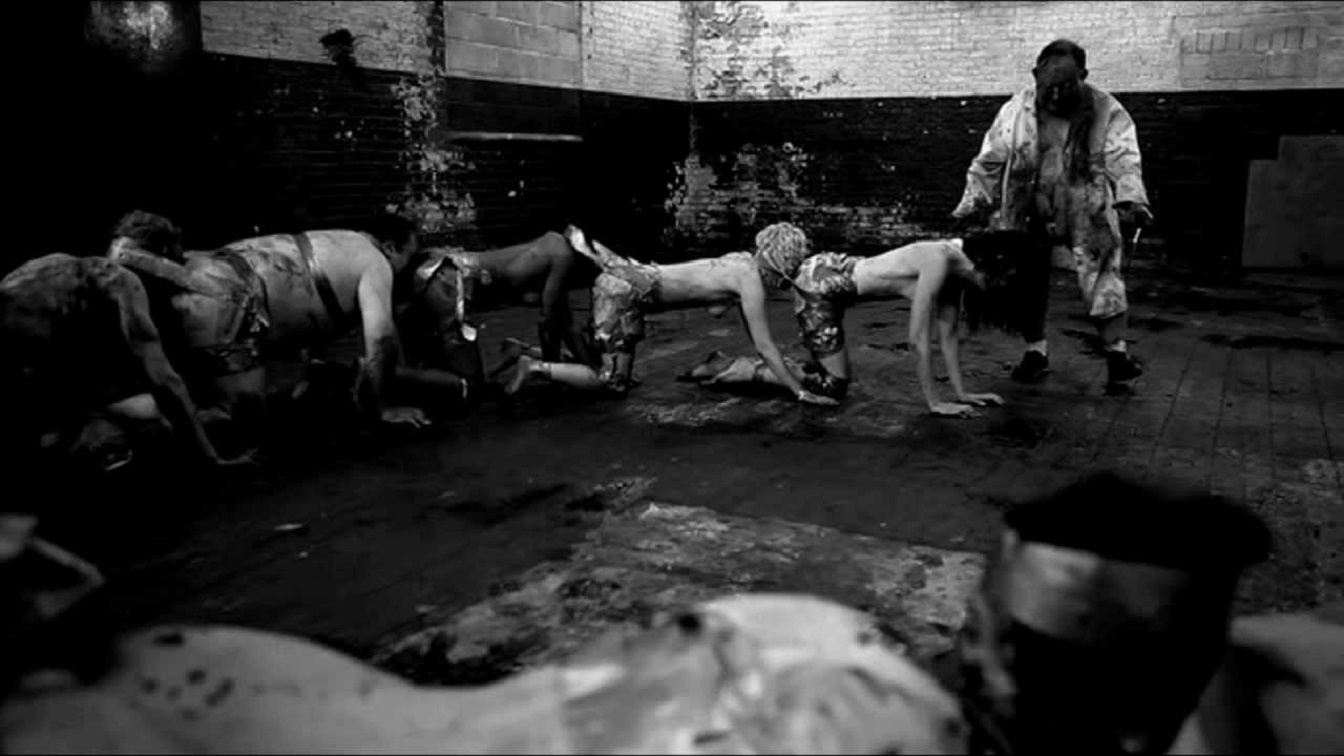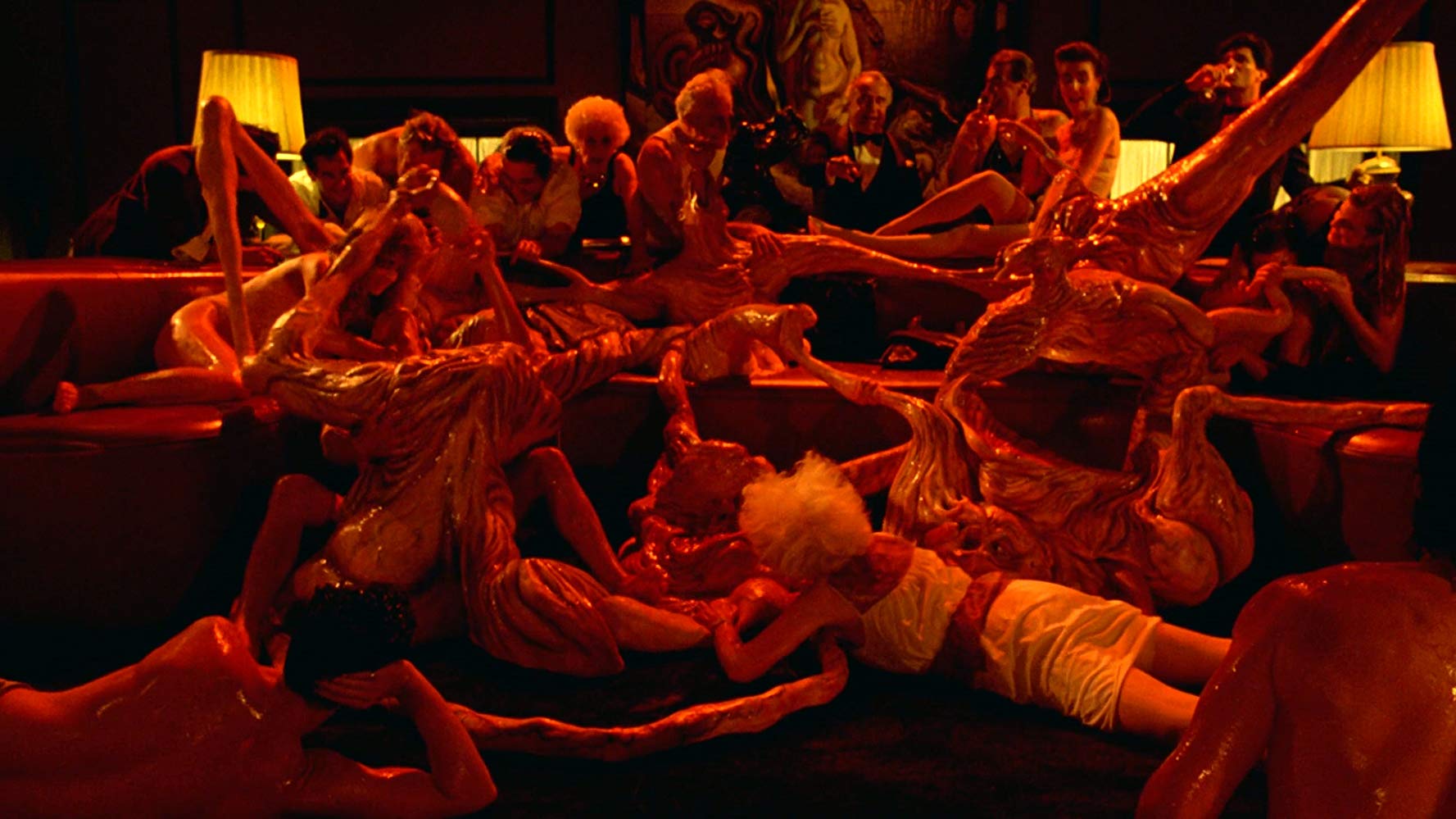Sexual Fetishism in Fantastic Cinema topics refers to alternate sexual practices (commonly referred to as philias) that are not covered elsewhere. For discussions of mainstream sexual practices in fantastic cinema see Sex in Fantastic Cinema and LGBT Themes in Fantastic Cinema. Some of the philias discussed here are so commonplace in their screen depictions that they have been split off as their own topics with the likes of BDSM in Fantastic Cinema and Films About Necrophilia. Fantastic films made with the intention of titillating are dealt with under the listing Erotica and Pornography in Fantastic Cinema.
This is a page that simply catalogues the ways in which each of these practices is depicted in fantastic cinema. It should not be construed in any way as a criticism of anybody’s personal practices nor for that matter support for any practices that are deemed illegal.
Acrotomophilia
Many films featuring mad surgeons perhaps unwittingly fall into the category of Acrotomophilia – a sexual obsession with surgery. Boxing Helena (1993) has surgeon Julian Sands becomes obsessed with Sherilyn Fenn whereupon he abducts her and operates to amputate her arms and legs in an effort to make her love him. In a similar vein was the Caterpillar episode of Rampo Noir (2005) where a wife sexually abuses a husband whose arms and legs have been blown off at war.
The Soska Sisters’ American Mary (2012) is set in an underground world of body modification wherein Katherine Isabelle’s surgeon is required to perform a variety of surgeries. Quite unique is Pedro Almodovar’s The Skin I Live In (2011) in which a surgeon transforms his daughter’s would-be rapist into a woman and then romances her.
There is Tom Six’s extraordinarily perverse trilogy The Human Centipede (First Sequence) (2009), The Human Centipede II (Full Sequence) (2011) and The Human Centipede 3 (Final Sequence) (2015), which concerns a sexual obsession with surgically connecting people into a single digestive system, a ring of people with mouths connected to each other’s anuses.
Autonepiophilia
Autonepiophilia is the practice of adults being treated as children – dressed in diapers, tended by nannies and wet nurses etc. This is the focus of the gonzo horror film Attack of the Adult Babies (2017).
Bestiality
Bestiality concerns itself with sex between humans and animals. This can be implied in several werewolf films and more directly so in Cat People (1982) in which people transform into leopards after having sex. King Kong (1933) in which a giant ape falls for a young blonde starlet can also be considered here.
Walerian Borowczyk’s The Beast (1975) features a scene where the heroine liaises with the title creature of unidentified species. The most overt of these would be the erotic film Tanya’s Island (1980) featuring a liaison between Vanity and an ape.
Bestiality was wittily spoofed in the What is Sodomy? segment of Woody Allen’s Everything You Always Wanted to Know About Sex * But Were Afraid to Ask (1972), which features Gene Wilder becoming obsessed with a sheep, taking her to a hotel room, requesting room service orders for bales of grass and with shots of the sheep clad in suspenders.

Cannibalism
Cannibalism – the eating of human flesh – is discussed under its own theme Films About Cannibalism. Cannibalism (at least on screen) is rarely an occasion when the motivation is sexual, although there have been a number of occasions when true-life serial killers such as Jeffrey Dahmer ate the body parts of their victims. The Dinner for Monsters segment of Late Night Double Feature (2016) features a chef required to cook a human body for a dinner party.
One notable example was the true-life case of German man Armin Meiwes who met another man over the internet and by mutual agreement cooked and ate his flesh. The Meiwes story appears on screen in Rohtenburg/Grimm Love (2006) and is referenced in a scene in Feed (2005).
There is also Claire Denis’s quite out-there Trouble Every Day (2001) about people who are driven to devour others during the act of sex.
Coprophilia/Scatophilia
Coprophilia is an obsession with faeces. The one major film to deal with this was the South Korean anime Aachi & Ssipak (2006) set in a future where the world has been based on excrement and the entire populace is obsessed with excretion.
Salo or 120 Days of Sodom (1975), one of the most extreme films ever made, has an uncomfortable to watch scene where someone gleefully eats a plate of shit. Coprophilia is played for laughs in The Proposition segment of Movie 43 (2013).
Although there is no philia for it, this seems the best place to include Butt Boy (2019), a gonzo film about a man who enjoys having objects inserted into his anus and is soon causing pets and children to disappear up there.
Paedophilia
Paedophilia (the sexual attraction to children) is perhaps one of the most demonised and taboo areas in modern society. Few films have been daring enough to broach it.
One such was Hard Candy (2005) where a thirtysomething paedophile Patrick Wilson lures a fourteen-year old Ellen Page to his house, only for her to turn the tables, tie him up and castrate him. The most disturbing work to dare this territory was the Austrian Michael (2011) about a paedophile and the young boy he keeps prisoner in his basement.
Sex Toys
Love Object (2003) features Desmond Harrington as a man who buys a blow-up sex doll only for it to take over and become jealous and demanding when he gets a real girlfriend.
Sitophilia and Feederism
Sitophilia concerns the sexual obsession with food. This features in the Sweets episode of The Theatre Bizarre (2011).
The sole film to deal with feederism – the relationship between a dominant party who feeds another with the intention of them becoming massively obese – was the fascinating Feed (2005), which pushed it to the level that had the feeder feeding the victim with the intention of killing them.

Invented Philias
The most fascinating of the entirely invented paraphilias was Incense for the Damned/Bloodsuckers (1969), which offered up a psychological explanation for vampirism as a perversion born of sexual repression. A similar fetish with blood-drinking appears in Fascination (1979) and Vampire (2011). There are plentiful examples of the mingling of vampires with erotica – see Vampire Films – but these are simply standard sex scenes in a film can not be said to represent vampirism as a philia.
Society (1989) depicts a secret society of shapechangers who engage in orgies where they are able to meld and shift their bodies into new shapes.
The strangest of these films about invented philias would be Jan Svankmajer’s surreal Conspirators of Pleasure (1996) about people engaged in strange fetishes – with making love to a tv newsreader’s image, putting bread balls up one’s nose, having your feet nibbled by fish and so on. Similar surreal fetishes also appear in Taxidermia (2006).
There is also the notion of ‘forbidden pleasures’, which are usually unspecified but offer something beyond normal experience but usually at a price. This was memorably used by Clive Barker in Hellraiser (1987), although watered down in the line of sequels. There was also the Alraune segment of German Angst (2015) where a patron discovers forbidden pleasures at a nightclub and The Special (2020) where a guy discovers the greatest sex of his life by placing his penis into a mysterious black box and becomes obsessed with it..
Other
There are a certain body of films that compete to push things to an extreme and catalogue the most perverse behaviours. Examples include the aforementioned Salo, Visitor Q (2001) and We Are the Flesh (2016), while A Serbian Film (2010) sets out to push things to the most extreme perversions possible. The L is for Libido segment of The ABCs of Death (2012) has various men in a competition where they must masturbate to orgasm over increasingly more perverse acts with the last to ejaculate being killed.
Fetish regularly appears in the works of David Cronenberg. One of his most notable was Shivers/The Parasite Murders/They Came from Within (1975) about parasites that turn their human hosts into sexual fetishists, while his early Crimes of the Future (1970) is a bizarre work set in a future where mutations have caused a need for people to lick skin, among others weirdnesses. Dead Ringers (1988) explores the psychology of two twin brothers and their perverse fascination with gynaecology. In particular, Crash (1996) depicts a fetish that may not exist – the sexual fascination with car crashes – and show a group of people determined to achieve consummation in vehicular accidents. The works of David Lynch also feature regular lashings of fetish, mostly of the BDSM variety.

Another director who loves to outrage with his extremes is Japan’s Takashi Miike who litters his films with casual perversity – in particular, Visitor Q. A good friend of Miike is Shinya Tsukamoto whose films all seem to centre around fetish. Tsukamoto’s most famous film was Tetsuo – The Iron Man (1989), about a man who is transformed into bizarre bio-mechanoid fusions of flesh and machinery and comes with the amazing image of a hero with its penis transformed into a drill bit that proceeds to tear his girlfriend apart.
Japanese animation concerns itself with a quite extraordinary degree of fetishism, BDSM fantasies and sexual sadism. One examples of this was Legend of the Overfiend (1989), concerning a horde of demons on Earth, who become engaged in all manner of sexual activities. Wicked City (1987) offers a near pathological depiction of sexuality with vaginas and breasts turning into deadly creatures.
Let My Puppets Come (1976) was a pornographic film featuring puppets, while Marquis (1989) is a retelling of the Marquis de Sade story using talking animals, and Peter Jackson’s Meet the Feebles (1990) features Muppet-like animals engaged in orgies, S&M and assorted not-for-kiddies activities.
There is also a small body of films dealing with genitalia that gain lives of their own. In Me and Him (1988) and leading him astray, Griffin Dunne’s penis starts talking to him, while in Bad Johnson (2014), Cam Gigandet’s penis gains a separate life of its own and starts making his life a misery.
Eating Raoul (1982) is also a black comedy about a couple who pose as kinksters and lure others to kill them off.
Recommendations
- Incense for the Damned (1969)
- Crimes of the Future (1970)
- The Beast (1975)
- Salo or 120 Days of Sodom (1975)
- Shivers/The Parasite Murders/They Came from Within (1975)
- Tanya’s Island (1980)
- Wicked City (1987)
- Dead Ringers (1988)
- Marquis (1989)
- Society (1989)
- Tetsuo – The Iron Man (1989)
- Meet the Feebles (1990)
- Boxing Helena (1993)
- Conspirators of Pleasure (1996)
- Crash (1996)
- Trouble Every Day (2001)
- Visitor Q (2001)
- Feed (2005)
- Hard Candy (2005)
- The Human Centipede (First Sequence) (2009)
- A Serbian Film (2010)
- The Human Centipede II (Full Sequence) (2011)
- Michael (2011)
- The Skin I Live In (2011)
- The L is for Libido segment of The ABCs of Death (2012)
- American Mary (2012)
A full list of titles can be found here Sexual Fetishism

